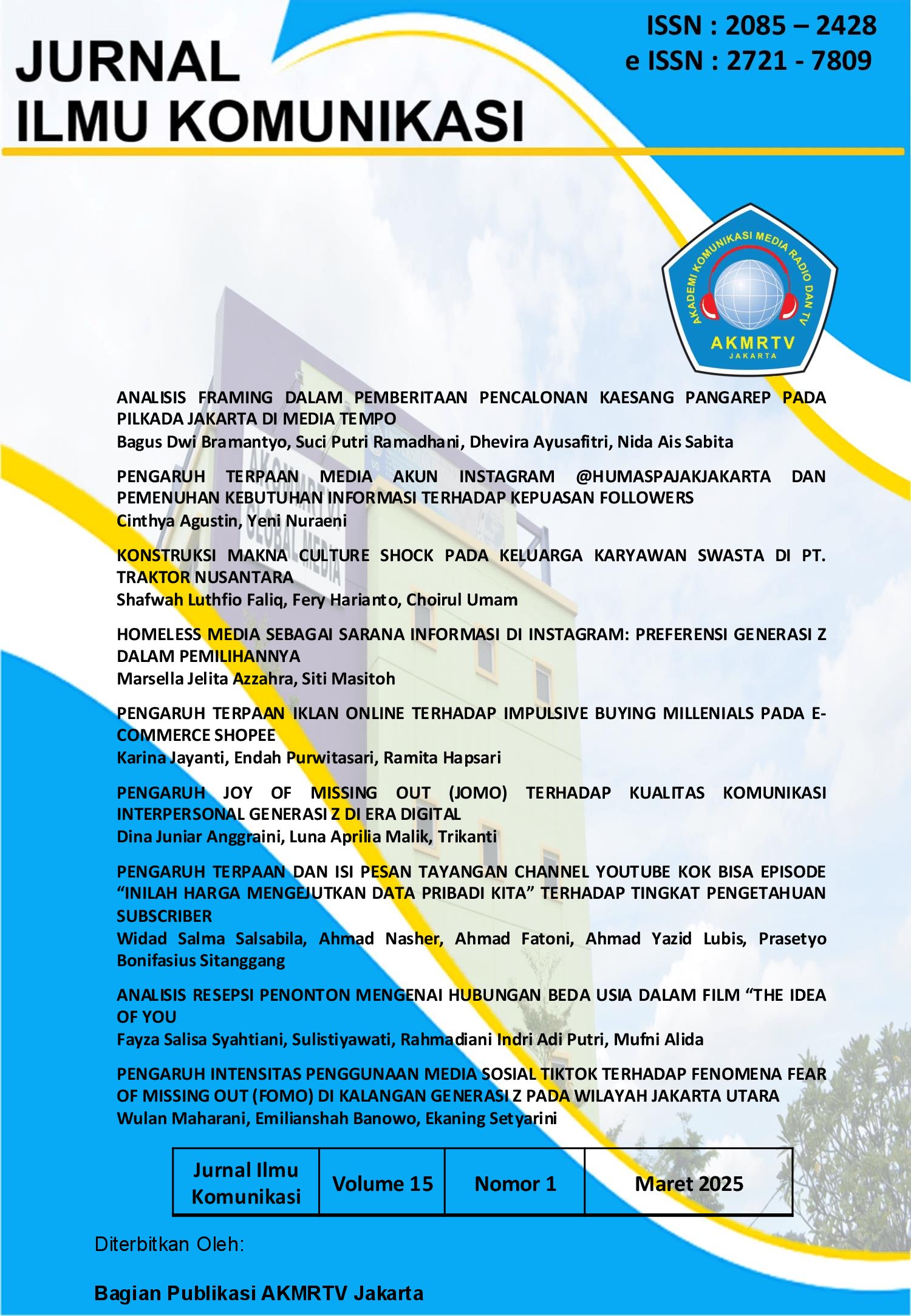PENGARUH TERPAAN MEDIA AKUN INSTAGRAM @HUMASPAJAKJAKARTA DAN PEMENUHAN KEBUTUHAN INFORMASI TERHADAP KEPUASAN FOLLOWERS
Keywords:
Media Exposure, Instagram, Information Needs, Followers Satisfaction, Media Richness TheoryAbstract
This study aims to analyze the influence of media exposure of Instagram account @humaspajakjakarta and fulfillment of information needs on followers' satisfaction. Media exposure of Instagram account @humaspajakjakarta and fulfillment of information needs simultaneously have a significant influence on followers' satisfaction. High media exposure, with a focus on frequency, attention, and duration triggers followers' satisfaction regarding the information provided is very interesting, accurate and complete so that followers understand taxation. Fulfillment of information needs includes Current need approach, Everyday Need Approach, Exhaustic Need Approach and Catching-up need approach also encourages followers' satisfaction regarding the delivery of tax information through content such as infographic images, text, and video tutorials. The research method used is the survey method - quantitative. Data collection techniques using questionnaires. The theoretical approach used is the Media Richness Theory. The population of this study was 58,700 thousand people who follow the Instagram account @humaspajakjakarta where the sampling used the Slovin formula to obtain 400 respondents using the Purposive Sampling technique. The type of data used is primary data, data obtained and analyzed using SPSS 25.0. The research results show that the media exposure of the Instagram account @humaspajakjakarta (X1) and the fulfillment of information needs (X2) simultaneously affect follower satisfaction by 65.7%, with the remaining 34.3% influenced by other variables not examined in this study. Partially, media exposure has an influence of 52.1%, while the fulfillment of information needs has an influence of 56.6% on follower satisfaction.
References
Ardianto, E., Komala, & Karlinah. (2004). Komunikasi Massa Suatu Pengantar. Bandung : Simbiosa Rekatama Media.
Cangara, H. (2010). Pengantar Ilmu Komunikasi. Jakarta: PT. Raja Grafindo Persada.
Daft, R. L., & Lengel, R. H. (1986). Organizational information require- ments, media richness, and structural design. Management Science, 554 -571.
Ghozali, I. (2011). Aplikasi Analisis Multivariate Dengan Program SPSS. Semarang : Badan Penerbit Universitas.
Helen, F. R. (2018). Pengaruh Penggunaan Media Sosial Akun Instagram @Jktinfo Terhadap Pemenuhan Kebutuhan Informasi. 355 - 362.
Kaplan, A. M., & Haenlein, M. (2010). Users Of The World Unite The Challenges And Opportunities Of Social Media.
Kotler, P., & Keller , K. L. (2012). Marketing Management. New Jersey: Pearson.
Kriyanto, R. (2006). Teknik Praktis Riset Komunikasi. Jakarta: Kencana Pernada Media Group.
Kriyantono, R. (2006). Teknik Praktis Riset Komunikasi. Jakarta: Kencana Prenada Media Group.
Littlejohn, S. W., & Foss, K. A. (2009). Teori Komunikasi. Jakarta: Salemba Humanika.
McQuail. (2011). Teori Komunikasi Massa. Jakarta: Salemba Humanika.
Ningsih, H. S. (2012). Kebutuhan Informasi dan Pemenuhan kebutuhan akan informasi:.
Puntoadi, D. (2011). Meingkatkan Penjualan Melalui Media Sosial. Jakarta: Gramedia Pustaka Utama.
Severin, W. J., & Tankard, J. W. (2011). Teori Komunikasi, Sejarah, Metode, Dan Terapan Di Dalam Media Massa. Jakarta: Kencana Prenada Media Group.
Sugiyono. (2012). Metode Penelitian Kuantitatif, Kualitatif, dan R&D. Bandung: CV Alfabeta.
Suharsimi, A. (2007). Dasar-Dasar Evaluasi Pendidikan. Jakarta: Bumi Aksara.
Suprapto. (2006). Pengantar Teori Komunikasi. Yogyakarta: Media Pressindo.

Downloads
Published
Issue
Section
License
Copyright (c) 2025 Cinthya Agustin, Yeni Nuraeni

This work is licensed under a Creative Commons Attribution-ShareAlike 4.0 International License.

















